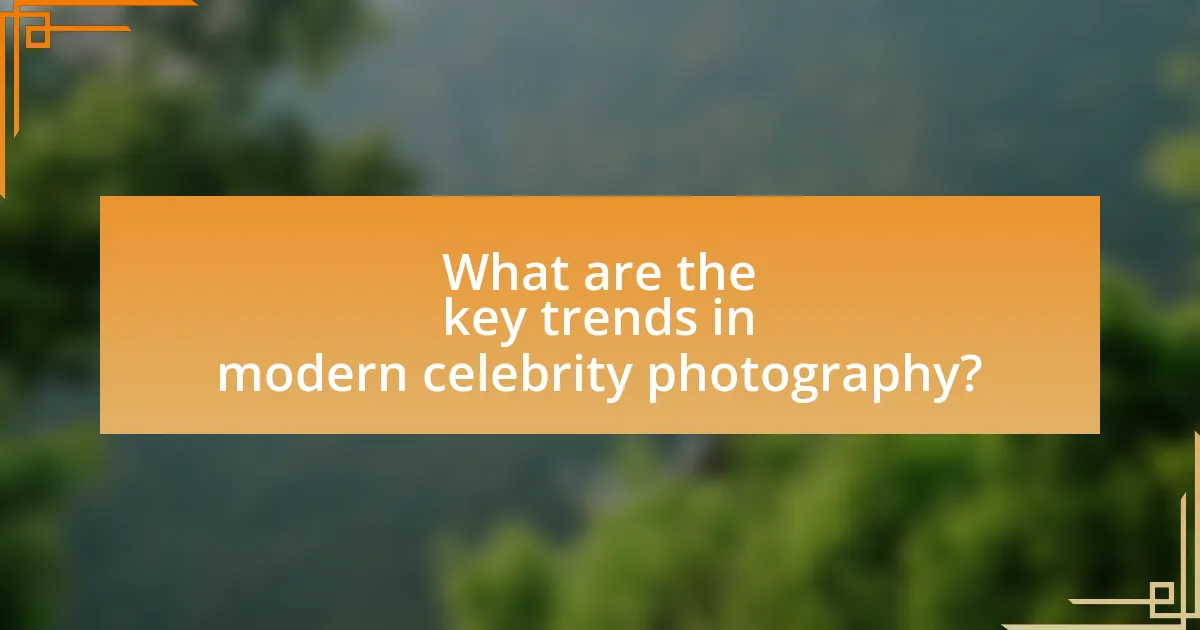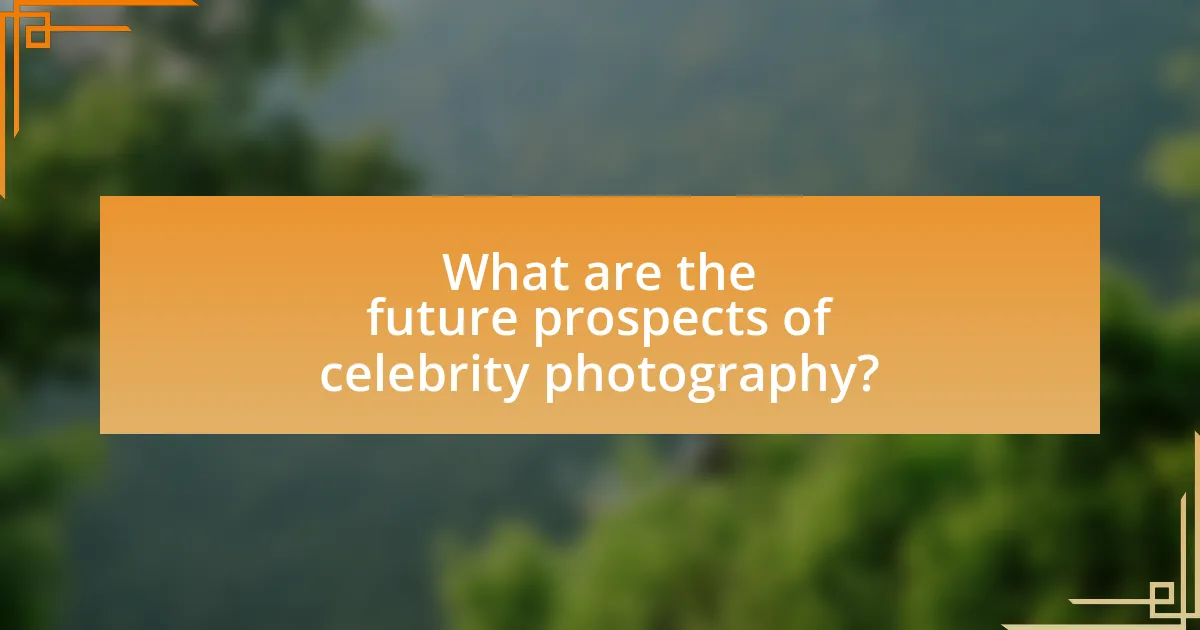The article examines the evolution of celebrity photography, tracing its journey from the traditional paparazzi era to the rise of social media influencers. It highlights key milestones, including the emergence of paparazzi in the 1950s, the impact of digital technology in the 1990s, and the significant role of platforms like Instagram and TikTok in shaping contemporary celebrity culture. The discussion includes the ethical implications of paparazzi practices, the influence of technology on image capture, and the changing dynamics of public perception regarding beauty standards and celebrity engagement. Additionally, it explores the strategies used by influencers to connect with audiences and the future prospects of celebrity photography in an increasingly digital landscape.

What is the Evolution of Celebrity Photography?
The evolution of celebrity photography has transitioned from traditional paparazzi styles to the pervasive influence of social media. Initially, in the mid-20th century, celebrity photography was dominated by paparazzi who captured candid moments of stars, often leading to legal and ethical controversies. This era was characterized by black-and-white images in magazines, which shaped public perception of celebrities.
With the advent of digital technology in the late 1990s and early 2000s, the landscape shifted significantly. The rise of the internet and social media platforms allowed celebrities to control their own narratives by sharing personal images directly with fans, reducing reliance on paparazzi. This shift has led to a more curated and polished representation of celebrity life, as seen on platforms like Instagram, where influencers and traditional celebrities alike engage directly with their audience.
The impact of this evolution is evident in the way celebrity culture is consumed today, with social media influencers emerging as a new category of celebrity, often blurring the lines between personal and public life. This transformation reflects broader changes in technology and media consumption, illustrating how celebrity photography has adapted to the digital age.
How has celebrity photography changed over the decades?
Celebrity photography has evolved significantly over the decades, transitioning from traditional paparazzi styles to the pervasive influence of social media. In the mid-20th century, celebrity photography primarily involved candid shots taken by paparazzi, often capturing stars in their private moments, which led to a culture of invasion of privacy. By the 1990s, the rise of magazines like People and Us Weekly popularized staged photoshoots, where celebrities collaborated with photographers to create polished images for public consumption.
In the 2000s, the advent of digital cameras and the internet shifted the landscape further, allowing celebrities to share their own images directly with fans through platforms like MySpace and later Instagram. This democratization of photography enabled stars to control their narratives and present curated versions of their lives. As of the 2020s, social media influencers have emerged as a new category, where photography is not just about capturing moments but also about branding and marketing, with influencers leveraging their images for commercial gain.
This evolution reflects broader societal changes in technology, privacy, and celebrity culture, illustrating how the medium and methods of celebrity photography have adapted to new platforms and audience expectations.
What were the key milestones in the history of celebrity photography?
The key milestones in the history of celebrity photography include the introduction of the first paparazzi in the 1950s, the rise of photojournalism in the 1960s, the establishment of celebrity magazines like People in the 1970s, the advent of digital photography in the 1990s, and the emergence of social media platforms in the 2000s. The 1950s marked the beginning of the paparazzi era, where photographers began to capture candid moments of celebrities, significantly influencing public perception. In the 1960s, photojournalism gained prominence, with images of celebrities becoming integral to news reporting. The 1970s saw the launch of magazines dedicated to celebrity culture, which popularized celebrity photography. The 1990s introduced digital photography, allowing for quicker and more accessible image capture and distribution. Finally, the 2000s brought social media, enabling celebrities to share their own images directly with fans, transforming the landscape of celebrity photography.
How did technological advancements influence celebrity photography?
Technological advancements significantly transformed celebrity photography by enhancing accessibility, speed, and quality of images. The introduction of digital cameras in the late 1990s allowed photographers to capture high-resolution images instantly, eliminating the need for film development and enabling real-time sharing. Additionally, the rise of smartphones equipped with advanced cameras democratized photography, allowing fans and amateur photographers to capture and disseminate images of celebrities on social media platforms. This shift not only increased the volume of celebrity images available but also changed the dynamics of celebrity culture, as public figures became more accessible and relatable through user-generated content. The impact of these advancements is evident in the rapid growth of platforms like Instagram, where visual storytelling has become central to celebrity branding and fan engagement.
What role do paparazzi play in celebrity photography?
Paparazzi play a crucial role in celebrity photography by capturing candid images of public figures, often without their consent. This practice has shaped public perception and media narratives surrounding celebrities, as these photographs frequently highlight personal moments, lifestyle choices, and public appearances. The demand for such images has led to a significant market for paparazzi work, with agencies and individual photographers selling exclusive shots to tabloids and entertainment outlets. The impact of paparazzi is evident in the way it influences celebrity culture, as seen in the rise of privacy concerns and legal battles over image rights, which have become prominent issues in the entertainment industry.
How did the paparazzi culture emerge?
The paparazzi culture emerged in the mid-20th century as a response to the growing public fascination with celebrities, particularly in Hollywood. This interest was fueled by the rise of mass media, including magazines and television, which created a demand for candid images of famous individuals. The term “paparazzi” itself originated from the character Paparazzo in Federico Fellini’s 1960 film “La Dolce Vita,” symbolizing aggressive photographers who pursued celebrities relentlessly. The commercialization of celebrity culture, combined with legal loopholes regarding privacy, allowed photographers to capture and sell unauthorized images, leading to the establishment of a lucrative industry focused on celebrity surveillance.
What are the ethical implications of paparazzi photography?
Paparazzi photography raises significant ethical implications primarily concerning privacy invasion and the mental well-being of individuals being photographed. The relentless pursuit of celebrities by paparazzi often leads to intrusive behavior, where personal moments are captured without consent, violating the right to privacy. For instance, the tragic death of Princess Diana in 1997 highlighted the dangers of aggressive paparazzi tactics, sparking widespread debate about the ethical boundaries of such photography. Furthermore, studies indicate that constant media scrutiny can lead to severe mental health issues for celebrities, including anxiety and depression, as they struggle with the lack of personal space and the pressure of public perception. These factors underscore the need for ethical considerations in the practice of paparazzi photography, balancing the public’s interest in celebrity culture with respect for individual rights.
How has social media transformed celebrity photography?
Social media has transformed celebrity photography by enabling direct engagement between celebrities and their audiences, allowing stars to share personal images and moments without intermediaries. This shift has diminished the traditional role of paparazzi, as celebrities now curate their own narratives and visual content through platforms like Instagram and Twitter. For instance, in 2020, a survey indicated that 70% of celebrities actively use social media to connect with fans, showcasing their lives and projects directly, which has led to a more intimate and authentic portrayal of celebrity life. This transformation has also resulted in a significant increase in the volume of celebrity images available online, as users frequently share and repost content, further blurring the lines between public and private life.
What platforms have become significant for celebrity photography?
Social media platforms such as Instagram, Twitter, and TikTok have become significant for celebrity photography. These platforms allow celebrities to share personal moments and professional updates directly with their audience, often bypassing traditional media outlets. For instance, Instagram’s visual-centric format has transformed how celebrities engage with fans, with over 1 billion monthly active users as of 2023, making it a primary venue for celebrity images and interactions. Additionally, TikTok’s rapid growth, with over 1 billion users, has introduced a new dynamic where celebrities can showcase their personalities through short videos, further influencing public perception and engagement.
How do social media influencers differ from traditional celebrities in photography?
Social media influencers differ from traditional celebrities in photography primarily through their direct engagement with audiences and the authenticity of their content. Influencers often utilize platforms like Instagram and TikTok to share personal, unfiltered images that resonate with their followers, fostering a sense of relatability. In contrast, traditional celebrities typically rely on professional photographers and curated images, often shaped by public relations teams, which can create a more polished but less personal representation. This shift is evidenced by the rise of influencer marketing, where brands prefer influencers for their perceived authenticity; a study by the Digital Marketing Institute found that 70% of millennials trust influencers more than traditional celebrities.

What are the key trends in modern celebrity photography?
Key trends in modern celebrity photography include the rise of social media platforms, which have shifted the focus from traditional paparazzi to self-curated images by celebrities themselves. This trend is evidenced by the fact that over 70% of celebrities actively engage with their audience through platforms like Instagram, where they control their narrative and visual representation. Additionally, there is an increasing emphasis on authenticity and relatability, as audiences prefer candid and behind-the-scenes content over highly polished images. This shift is supported by studies indicating that 60% of consumers are more likely to engage with brands that feature authentic content. Furthermore, the use of advanced technology, such as drones and high-quality smartphone cameras, has democratized photography, allowing both professionals and amateurs to capture high-quality images.
How do influencers shape the current landscape of celebrity photography?
Influencers significantly shape the current landscape of celebrity photography by prioritizing authenticity and direct engagement with their audiences. Unlike traditional celebrity photography, which often relies on paparazzi and staged events, influencers curate their own images and narratives through social media platforms, allowing for a more personal connection with followers. This shift has led to a democratization of celebrity culture, where influencers can gain substantial visibility and influence without the traditional gatekeepers of the entertainment industry. For instance, platforms like Instagram report that influencers can achieve higher engagement rates than traditional celebrities, with some influencers amassing millions of followers and shaping trends in real-time. This evolution reflects a broader cultural shift towards valuing relatability and personal branding in the realm of celebrity photography.
What strategies do influencers use to engage their audience through photography?
Influencers engage their audience through photography by utilizing visually appealing content, storytelling, and interactive elements. They often curate aesthetically pleasing images that resonate with their followers’ interests, enhancing emotional connection. Storytelling is employed through captions and sequences of images that convey a narrative, making the content relatable and memorable. Additionally, influencers incorporate interactive elements such as polls, questions, and challenges in their posts, encouraging audience participation and fostering a sense of community. These strategies are effective as they not only attract attention but also promote engagement, leading to higher interaction rates and follower loyalty.
How does influencer photography differ from paparazzi photography?
Influencer photography differs from paparazzi photography primarily in intent and context. Influencer photography is typically curated and staged, aimed at promoting a personal brand or product, often shared on social media platforms for engagement and marketing purposes. In contrast, paparazzi photography captures candid moments of celebrities, often without their consent, focusing on private or unguarded situations to generate sensational news or gossip. This distinction highlights the controlled nature of influencer photography versus the invasive approach of paparazzi photography, reflecting the evolving landscape of celebrity representation in the digital age.
What impact does celebrity photography have on public perception?
Celebrity photography significantly shapes public perception by influencing societal standards of beauty, lifestyle, and behavior. The portrayal of celebrities in various contexts, whether glamorous or candid, creates aspirational images that the public often seeks to emulate. Research indicates that exposure to idealized images can lead to altered self-esteem and body image perceptions among viewers, particularly among adolescents. For instance, a study published in the journal “Body Image” found that individuals exposed to celebrity images reported higher levels of body dissatisfaction. This demonstrates that celebrity photography not only reflects but also actively constructs public ideals and norms, impacting how individuals perceive themselves and others in society.
How does celebrity photography influence societal standards of beauty?
Celebrity photography significantly influences societal standards of beauty by shaping public perceptions of attractiveness and desirability. The portrayal of celebrities in various media often emphasizes specific physical traits, such as slimness, flawless skin, and particular fashion styles, which can create unrealistic beauty ideals. Research indicates that exposure to idealized images can lead to body dissatisfaction among individuals, particularly young women, as they compare themselves to these often digitally altered representations. A study published in the journal “Body Image” found that women exposed to images of thin models reported lower self-esteem and higher body dissatisfaction. Thus, celebrity photography not only reflects but actively constructs societal beauty norms, impacting individual self-image and societal expectations.
What role does celebrity photography play in shaping trends and culture?
Celebrity photography significantly influences trends and culture by creating visual narratives that shape public perception and consumer behavior. This form of photography captures celebrities in various contexts, from red carpet events to candid moments, which are widely disseminated through media platforms. As a result, these images often set fashion trends, lifestyle aspirations, and social norms, as seen in the rise of specific clothing brands or beauty products endorsed by celebrities. For instance, the popularity of certain fashion items can be traced back to their appearance in celebrity photographs, leading to increased sales and cultural adoption. Furthermore, the accessibility of celebrity images on social media platforms has democratized influence, allowing fans to engage with and emulate their favorite stars, thereby reinforcing cultural trends.

What are the future prospects of celebrity photography?
The future prospects of celebrity photography are increasingly tied to digital platforms and social media, where influencers and celebrities curate their own images. As traditional paparazzi methods decline, the rise of personal branding through platforms like Instagram and TikTok allows celebrities to control their narratives and engage directly with fans. This shift is supported by data indicating that over 1 billion people use Instagram monthly, highlighting the platform’s significance in celebrity culture. Additionally, advancements in technology, such as AI and augmented reality, are likely to further transform how celebrity images are captured and shared, making the field more dynamic and interactive.
How might technology further change celebrity photography?
Technology will further change celebrity photography by enhancing image capture and distribution through advancements in artificial intelligence, drones, and social media platforms. AI algorithms can analyze and predict trends in celebrity appearances, allowing photographers to capture more compelling images tailored to audience preferences. Drones provide unique aerial perspectives, enabling photographers to capture celebrities in dynamic environments, while social media platforms facilitate instant sharing and engagement, altering how images are consumed and disseminated. For instance, the rise of platforms like Instagram has already shifted the focus from traditional paparazzi to influencers, demonstrating how technology reshapes the landscape of celebrity photography.
What emerging technologies could influence the way we capture celebrity moments?
Emerging technologies such as artificial intelligence, augmented reality, and drone photography are significantly influencing the way we capture celebrity moments. Artificial intelligence enhances image recognition and editing, allowing for real-time processing and improved quality of photos. Augmented reality enables interactive experiences, allowing fans to engage with celebrities in innovative ways through apps and social media platforms. Drone photography provides unique aerial perspectives, capturing candid moments from angles previously inaccessible, thus transforming traditional celebrity photography. These technologies collectively enhance the immediacy, creativity, and accessibility of capturing celebrity moments.
How might privacy concerns evolve in the context of celebrity photography?
Privacy concerns in celebrity photography are likely to evolve as technology advances and societal norms shift. With the rise of social media, celebrities face increased scrutiny and exposure, leading to heightened privacy invasions. For instance, the use of drones and high-resolution cameras allows photographers to capture images from greater distances, making it harder for celebrities to maintain personal boundaries. Additionally, legal frameworks may adapt to address these concerns, as seen in California’s anti-paparazzi laws, which have been enacted to protect celebrities from invasive photography. As public interest in celebrities continues to grow, the balance between public fascination and individual privacy rights will become increasingly contentious, necessitating ongoing dialogue and potential regulatory changes.
What best practices should photographers follow in the celebrity photography realm?
Photographers in the celebrity photography realm should prioritize respect for privacy, professionalism, and ethical standards. Respecting the privacy of celebrities is crucial, as it fosters trust and maintains a positive relationship, which is essential in an industry often scrutinized for invasive practices. Professionalism involves being prepared, punctual, and maintaining a courteous demeanor, which enhances the photographer’s reputation and increases the likelihood of future opportunities. Ethical standards dictate that photographers should avoid misleading or manipulative tactics, such as staging scenarios or misrepresenting situations, to ensure authenticity in their work. These best practices are supported by industry guidelines from organizations like the National Press Photographers Association, which emphasizes the importance of ethical conduct in photography.
How can photographers balance creativity and ethics in their work?
Photographers can balance creativity and ethics by adhering to established ethical guidelines while exploring innovative techniques. Ethical standards, such as respecting privacy and obtaining consent, are crucial in maintaining trust and integrity in photography. For instance, the National Press Photographers Association emphasizes the importance of ethical practices, which include not exploiting subjects and being transparent about the intent of the work. By integrating these ethical considerations into their creative processes, photographers can produce compelling images that honor their subjects and uphold professional standards.
What tips can help aspiring photographers succeed in celebrity photography?
Aspiring photographers can succeed in celebrity photography by building a strong portfolio, networking effectively, and understanding the nuances of celebrity culture. A strong portfolio showcases versatility and skill, which is essential for attracting clients and gaining credibility in the industry. Networking with industry professionals, including publicists and other photographers, can lead to valuable opportunities and collaborations. Additionally, understanding the dynamics of celebrity culture, including privacy concerns and the impact of social media, allows photographers to navigate the field more effectively. For instance, a study by the Pew Research Center indicates that 72% of adults use social media, highlighting the importance of adapting to platforms where celebrities engage with their audience.



